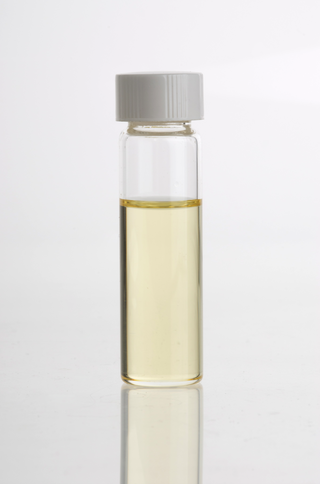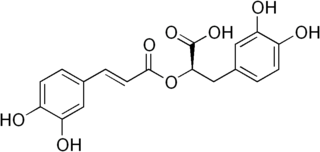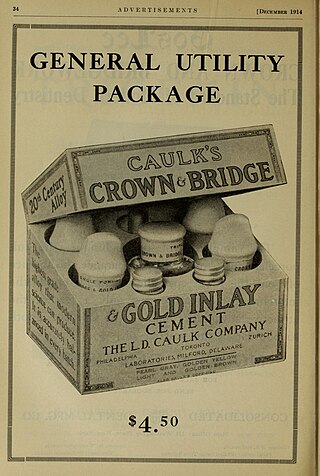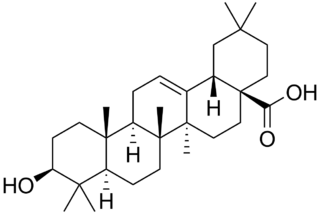
Cloves are the aromatic flower buds of a tree in the family Myrtaceae, Syzygium aromaticum. They are native to the Maluku Islands, or Moluccas, in Indonesia, and are commonly used as a spice, flavoring, or fragrance in consumer products, such as toothpaste, soaps, or cosmetics. Cloves are available throughout the year owing to different harvest seasons across various countries.

An essential oil is a concentrated hydrophobic liquid containing volatile chemical compounds from plants. Essential oils are also known as volatile oils, ethereal oils, aetheroleum, or simply as the oil of the plant from which they were extracted, such as oil of clove. An essential oil is essential in the sense that it contains the essence of the plant's fragrance—the characteristic fragrance of the plant from which it is derived. The term "essential" used here does not mean indispensable or usable by the human body, as with the terms essential amino acid or essential fatty acid, which are so called because they are nutritionally required by a living organism.

Basil, also called great basil, is a culinary herb of the family Lamiaceae (mints). It is a tender plant, and is used in cuisines worldwide. In Western cuisine, the generic term "basil" refers to the variety also known as sweet basil or Genovese basil. Basil is native to tropical regions from Central Africa to Southeast Asia. In temperate climates basil is treated as an annual plant, however, basil can be grown as a short-lived perennial or biennial in warmer horticultural zones with tropical or Mediterranean climates.
Zinc oxide eugenol (ZOE) is a material created by the combination of zinc oxide and eugenol contained in clove oil. An acid-base reaction takes place with the formation of zinc eugenolate chelate. The reaction is catalysed by water and is accelerated by the presence of metal salts. ZOE can be used as a dental filling material or dental cement in dentistry. It is often used in dentistry when the decay is very deep or very close to the nerve or pulp chamber. Because the tissue inside the tooth, i.e. the pulp, reacts badly to the drilling stimulus, it frequently becomes severely inflamed and precipitates a condition called acute or chronic pulpitis. This condition usually leads to severe chronic tooth sensitivity or actual toothache and can then only be treated with the removal of the nerve (pulp) called root canal therapy. For persons with a dry socket as a complication of tooth extraction, packing the dry socket with a eugenol-zinc oxide paste on iodoform gauze is effective for reducing acute pain. The placement of a ZOE "temporary" for a few to several days prior to the placement of the final filling can help to sedate the pulp. But, ZOE had in vitro cytotoxicity majorly due to release of Zn ions, not eugenol. In spite of severe in vitro cytotoxicity, ZOE showed relatively good biocompatibility in animal study when ZOE was applied on dentin. When ZOE was used as dentin-protective based materials, use of dental composite resin on ZOE was strongly prevented due to its inhibition of resin polymerization through radical scavenging effect. It is classified as an intermediate restorative material and has anaesthetic and antibacterial properties. The exact mechanism of anesthetic effect from ZOE was not revealed perfectly, but possibly through anti-inflammatory effect, modulating immune-cells to less inflamed status.

Linalool refers to two enantiomers of a naturally occurring terpene alcohol found in many flowers and spice plants. Linalool has multiple commercial applications, the majority of which are based on its pleasant scent. A colorless oil, linalool is classified as an acyclic monoterpenoid. In plants, it is a metabolite, a volatile oil component, an antimicrobial agent, and an aroma compound. Linalool has uses in manufacturing of soaps, fragrances, food additives as flavors, household products, and insecticides. Esters of linalool are referred to as linalyl, e.g. linalyl pyrophosphate, an isomer of geranyl pyrophosphate.

Ocimum tenuiflorum, commonly known as holy basil or tulsi, is an aromatic perennial plant in the family Lamiaceae. It is native to tropical and subtropical regions of Australia, Malesia, Asia, and the western Pacific. It is widely cultivated throughout the Southeast Asian tropics. This plant has escaped from cultivation and has naturalized in many tropical regions of the Americas. It is an agricultural and environmental weed.
Guaiacol is an organic compound with the formula C6H4(OH)(OCH3). It is a phenolic compound containing a methoxy functional group. Guaiacol appears as a viscous colorless oil, although aged or impure samples are often yellowish. It occurs widely in nature and is a common product of the pyrolysis of wood.

Caryophyllene, more formally (−)-β-caryophyllene (BCP), is a natural bicyclic sesquiterpene that is a constituent of many essential oils, especially clove oil, the oil from the stems and flowers of Syzygium aromaticum (cloves), the essential oil of Cannabis sativa, copaiba, rosemary, and hops. It is usually found as a mixture with isocaryophyllene and α-humulene, a ring-opened isomer. Caryophyllene is notable for having a cyclobutane ring, as well as a trans-double bond in a 9-membered ring, both rarities in nature.

Oil of clove, also known as clove oil or eugenol, is an essential oil extracted from the clove plant, Syzygium aromaticum. Clove oil is commonly used in aromatherapy and for flavoring food, tea, and toothpaste. In alternative medicine, it may be used as a topical medication to relieve toothache. There is insufficient medical evidence to support its use as an analgesic for treating pain.

Fenchol or 1,3,3-trimethyl-2-norbornanol is a monoterpenoid and an isomer of borneol. It is a colorless or white solid. It occurs widely in nature.

Rosmarinic acid, named after rosemary, is a polyphenol constituent of many culinary herbs, including rosemary, perilla, sage, mint, and basil.

A luting agent is a dental cement connecting the underlying tooth structure to a fixed prosthesis. To lute means to glue two different structures together. There are two major purposes of luting agents in dentistry – to secure a cast restoration in fixed prosthodontics, and to keep orthodontic bands and appliances in situ.

Methyl cinnamate is the methyl ester of cinnamic acid and is a white or transparent solid with a strong, aromatic odor. It is found naturally in a variety of plants, including in fruits, like strawberry, and some culinary spices, such as Sichuan pepper and some varieties of basil. Eucalyptus olida has the highest known concentrations of methyl cinnamate (98%) with a 2–6% fresh weight yield in the leaf and twigs.

Oleanolic acid or oleanic acid is a naturally occurring pentacyclic triterpenoid related to betulinic acid. It is widely distributed in food and plants where it exists as a free acid or as an aglycone of triterpenoid saponins.

Ocimum gratissimum, also known as clove basil, African basil, and in Hawaii as wild basil, is a species of basil. It is native to Africa, Madagascar, southern Asia, and the Bismarck Archipelago, and naturalized in Polynesia, Hawaii, Mexico, Panama, West Indies, Brazil, and Bolivia.

Greek basil is a flowering herb and cultivar of basil.

Acetyleugenol is a phenylpropanoid compound found in cloves. It is the second in abundance to the related compound eugenol in certain extract preparations. Like eugenol, its found in several plants such as Acacia nilotica and Piper betle and has similar antibacterial and antifungal properties on C. albicans and S. mutans. It inhibits aggregation of platelets and has partial agonistic activity on AhR.


















